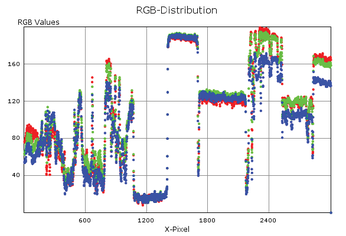Automate your color correction with a Perl script
Card Trick

© articular, Fotolia
If you have grown tired of manually correcting color-casted images (as described in last month's Perl column), you might appreciate a script that automates this procedure.
Last month, I wrote about using reference cards to correct the white balance in digital photos by taking a test snapshot (see Figure 1) [2]. The black, white, and gray plastic cards, which are available from any good photography equipment dealer, should not generate any color values in a digital image. This provides three calibration points for low, medium, and high light intensity, which the GIMP photo editing tool can then reference to correct your snapshots.
 Figure 1: Discovering the color values for the three cards in the picture – the script reads the RGB values along the horizontal line at the center to obtain the graph in
Figure 1: Discovering the color values for the three cards in the picture – the script reads the RGB values along the horizontal line at the center to obtain the graph in
[...]
Buy this article as PDF
(incl. VAT)
Buy Linux Magazine
Subscribe to our Linux Newsletters
Find Linux and Open Source Jobs
Subscribe to our ADMIN Newsletters
Support Our Work
Linux Magazine content is made possible with support from readers like you. Please consider contributing when you’ve found an article to be beneficial.

News
-
Two New Distros Adopt Enlightenment
MX Moksha and AV Linux 25 join ranks with Bodhi Linux and embrace the Enlightenment desktop.
-
Solus Linux 4.8 Features Removes Python 2
Solus Linux 4.8 has been released with the latest Linux kernel, updated desktops, and a key removal.
-
Zorin OS 18 Hits over a Million Downloads
If you doubt Linux isn't gaining popularity, you only have to look at Zorin OS's download numbers.
-
TUXEDO Computers Scraps Snapdragon X1E-Based Laptop
Due to issues with a Snapdragon CPU, TUXEDO Computers has cancelled its plans to release a laptop based on this elite hardware.
-
Debian Unleashes Debian Libre Live
Debian Libre Live keeps your machine free of proprietary software.
-
Valve Announces Pending Release of Steam Machine
Shout it to the heavens: Steam Machine, powered by Linux, is set to arrive in 2026.
-
Happy Birthday, ADMIN Magazine!
ADMIN is celebrating its 15th anniversary with issue #90.
-
Another Linux Malware Discovered
Russian hackers use Hyper-V to hide malware within Linux virtual machines.
-
TUXEDO Computers Announces a New InfinityBook
TUXEDO Computers is at it again with a new InfinityBook that will meet your professional and gaming needs.
-
SUSE Dives into the Agentic AI Pool
SUSE becomes the first open source company to adopt agentic AI with SUSE Enterprise Linux 16.


